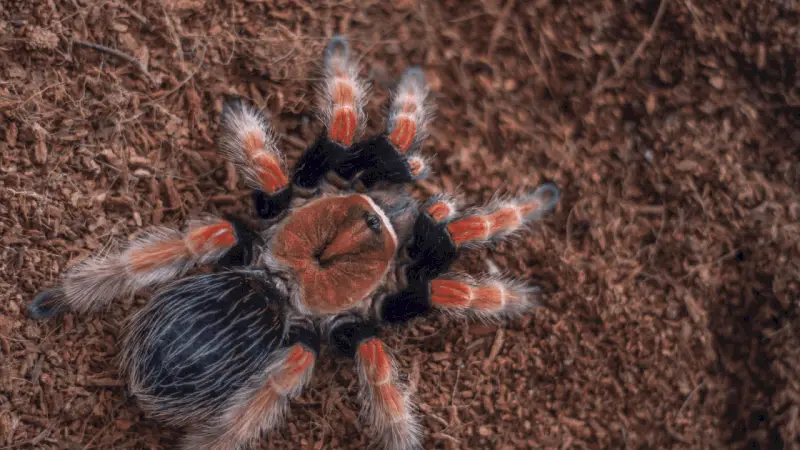How do I know if my tarantula is dying? It is difficult to tell when a tarantula is dying. Many owners mistake molting for dying. Before you bury or flush it, let’s examine the differences and what each looks like.
Tarantulas are susceptible to many items. Making sure your pet is well is a constant chore. Tarantulas also molt and many owners confuse this and treat the pet as if it is dead.
The most important thing to remember is that a dead or dying tarantula will be on its abdomen with its legs curled underneath him. A tarantula laying on its back is usually just molting.

How do I know if My Tarantula is Dying?
What are the signs that indicate your tarantula is dying? There are a few reasons. Some of them are fatal and some of them can be improved if caught in time.
1. Dyskinetic Syndrome
The biggest offender is DKS. DKS stands for Dyskinetic Syndrome which means abnormal movement. The tarantula will show signs of jerky, uncoordinated movement or be unable to move.
DKS almost alway is fatal. No one truly knows what causes it. Not only do the tarantulas demonstrate these jerky movements, it can’t eat or drink either.
The tarantula becomes dehydrated and succumbs to DKS. There isn’t any type of cure or known cause at this time.
Some believe pesticides cause DKS. These pesticides could be in the substrate, coming from nicotine due to someone smoking near the enclosure, or even the flea and tick medicine you use for your dogs and cats.
But, it could also be from mold in the substrate which has invaded the tarantula’s body. Another problem could be mites or bacteria in the substrate.
If bacteria or microorganisms invade the body of a tarantula, there is little that an owner can do. You can’t give antibiotics to a tarantula and it’s highly unlikely your veterinarian will know how to treat it.
2. Falls
An early warning sign that your tarantula might be dying is a white fluid coming from the abdomen or one of the tarantula’s legs as a result of a fall.
A tarantula was not meant to have a fall of any kind or from any great distance. Even a tiny fall can be fatal. Sometimes, in a fall, the abdomen of the tarantula ruptures.
The white fluid — called hemolymph or the tarantula’s “blood” — might start spilling out. The only way to keep your tarantula from bleeding to death is to use superglue or cornstarch to glue the abdomen back together.
Corn starch has been proven to clot the tarantula’s hemolymph. You must then create an “ICU” for your pet. Follow these steps:
- Take an enclosure or cup slightly larger than the tarantula
- Place a few damp paper towels in the bottom of the enclosure or cup
- Hope for the best and keep your eyes on the tarantula to intervene if anything else should happen.
You can also allow the enclosure to be a little warmer than usual. But don’t go overboard on this because you can easily dehydrate or cook the tarantula.
You should also do this if your tarantula has injured its leg. Tarantulas have a valve in their abdomen which can shut off the flow to the injured leg too.
Keep in mind, tarantulas can regenerate their limbs and often will self amputate one.
Are There Any Other Signs My Tarantula is Dying?
The answer is a resounding yes. If your tarantula is low to the ground and doesn’t move for a period, you should start monitoring the animal and try to determine what might be causing this behavior.
Also, if the tarantula is sluggish, you know that something might be wrong.
Here are a few points to consider:
- Did the tarantula recently molt?
- Was the tarantula’s behavior normal before this?
- Do his colors appear dull?
- Did it spin a web into a flat mat on the ground?
- Is its abdomen distended and appears like a balloon?
- Did the tarantula stop eating?
- Has a bald spot appeared on the abdomen?
If the answer to any of the above is yes, then your tarantula might be preparing to molt. A tarantula who is getting ready to molt, will stop eating, become sluggish and will build a flat mat on the substrate to lay on while molting.
Don’t panic yet. Take a deep breath and relax.
Molting is the process a tarantula undergoes while growing. The tarantula is getting ready to shed its exoskeleton or the hard shell covering the outer part of him.
Tarantulas are susceptible during this phase and should be monitored. One of the things to remember is a dying tarantula doesn’t lay on its back to die.
Tarantulas die facing downwards with its legs underneath it. Molting always occurs while the tarantula is on its back.
So if That’s Molting, What are other signs?
We covered molting, DKS and falls. Another sign your tarantula is dying is a wrinkled abdomen. If the abdomen is flat and withered, this is a sign of dehydration. If your tarantula lays down in its water dish for any length of time, it’s also a sign of dehydration. You can rehydrate the tarantula and, hopefully, save it. Again, it’s time for the ICU.
Take your pet and place it in a cup or enclosure. Add the damp paper towel and let the tarantula stay for at least 24 hours. This should rehydrate him and start him on the path of getting healthy.
However, while your pet is in the ICU, the enclosure, humidity and your care need to be evaluated. Dehydration usually means the enclosure is too hot or the humidity is too low.
Additionally, you can check the substrate to be sure that it is moist and doesn’t have any mold or mushrooms in it. These are both fungus and aren’t good for your tarantula.
And last, but not least, are you giving your pet water or misting often enough? Think about increasing the frequency that you give him water.
The last sign is one that most owners don’t want to observe. If your tarantula isn’t eating and isn’t moving, then this could be a sign of impending death.
Male spiders live until seven or eight years of age. Female spiders live longer and some have lived more than 20 years. But, if you notice your tarantula’s legs curling underneath him, this is a bad sign.
Again, you have to think of all the issues listed before. Has your tarantula recently molted? Or spun a flat mat on the substrate?
If these signs are present and the tarantula molted a few weeks ago, then you might have to assume the tarantula is dying.
A tarantula loses the pressure in its body, which in turn causes the animal to be unable to hold its own weight and the legs start to curl underneath it.
Some call this the death curl as this doesn’t happen when your tarantula is stressed or molted.
Remember, molting happens while the tarantula is on its back. This could happen due to old age or one of the other problems listed above.
But, how can you tell if the tarantula has actually died. Tarantulas don’t get stiff like mammals do. Tarantulas actually get soft.
The abdomen is flat and the body is soft. Most experts will tell you that if the abdomen in flat and soft, then your tarantula is dead.
It is unfortunate to have a tarantula die in your care, but usually there is not much that you can do to intervene.
Most tarantulas can maintain their health on their own with adequate hydration and feeding. But, tarantulas are delicate creatures and can easily get sick and die.








